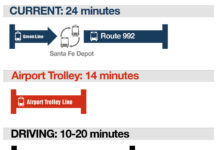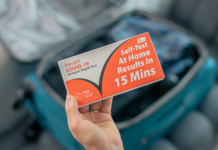Ridership on the Metropolitan Transit System (MTS) Bus and Trolley network has climbed by more than 50,000 trips in the first seven months of Fiscal Year 2019, which began on July 1, 2018. The gains have been led by the Trolley, which has posted six straight months of year-over-year gains.
“This is great news for the goals of the region’s various Climate Action Plans and for riders. This shows there is a real mandate to invest in improving transit,” said Georgette Gómez, MTS Chair and Council President of the City of San Diego.
Public transit ridership has dropped in most systems in the United States over the past several years. MTS was one of the last systems to experience a drop and it may, if trends continue, be one of the first to reverse the trend.
For the first seven months of FY19, Trolley ridership is up 1 percent from 21,810,915 trips to 22,037,351 trips. Fixed-route bus ridership has dropped less than 1% to 27,792,758 trips for the fiscal year to date.
“These numbers are highly encouraging,” said Paul Jablonski, MTS chief executive officer. “In January of last year, MTS began implementing many route changes that increased frequency on our high-demand routes. We completed making changes in January of this year and we’ve already begun to see the results.”
While Trolley ridership has led the resurgence, bus ridership has held steady and two major developments may put its ridership into the plus column soon.
In late January, the South Bay Rapid opened and average weekday ridership on that line is about 1,500 and climbing. The addition of this service from Otay Mesa to downtown, as well as the opening of a modern transit center just north of the Otay Mesa Border Crossing, has caused other routes serving the area to increase as well.
Additionally, MTS replaced shuttles operated by UC San Diego by adding service to Rapid Superloop routes at the end of January. These routes, serving the University City area, are showing weekday ridership gains of more than 3,000 trips per day.
February will be the first complete month in which these substantial gains will be recorded to bus ridership.
“It is clear that mobility is a highly competitive market,” Jablonski said. “And it is becoming evident that the integration of mobility options can be beneficial to everyone. MTS is working hard to not only maximize its service, but also provide technology to allow people to use their mobile phones for ticketing, real-time information and last-mile solutions.”
MTS operates 95 bus routes and three Trolley lines on 53 miles of double-tracked railway. Every weekday 300,000 passenger trips are taken on MTS bus and Trolley services in 10 cities and unincorporated areas of the county. In FY 2018, MTS served more than 86 million riders. For more information on how you can use public transportation and save money, go to www.sdmts.com




